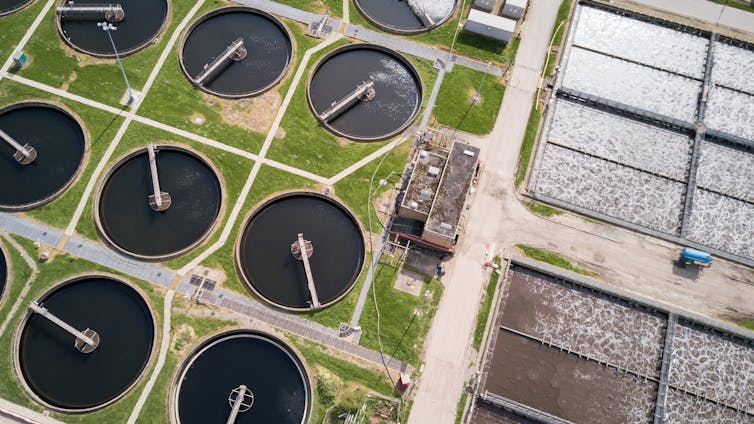Wicked problems are issues so complex and dependent on so many factors that it is hard to grasp what exactly the problem is, or how to tackle it. Wicked problems are like a tangled mess of thread – it’s difficult to know which to pull first. Increasing antibiotic resistance, security of food and energy supply, increasing global warming and wars can all be classed as wicked problems.
Since its first definition in 1973, many authors have associated the term “wicked” with water problems, which we research. Old water networks, bursting pipes, leakages, hosepipe bans – keeping the water supply running is a daily concern all over the world.
This shouldn’t be surprising – even in places where water seems abundant, small changes in rainfall patterns can affect local supply. For example, this summer in Ireland, there were less than sufficient levels of rainfall. The dry spell only could be compared to the one experienced by the country in 1976.
As a result, the country’s water reservoirs fell to such low levels that water authorities issued warnings of an imminent crisis. As in other places around the globe, the problem in Ireland is linked to multiple factors. These include the drier than expected summer, increased water demand, water leakage – nearly 50% – and a chronic underinvestment in renewing local water distribution systems. Meanwhile, the water treatment industry is the fourth most energy-intensive industry in the UK.

Pumping money into researching water technology is not the answer here. Yes, we all know that research underpins new technologies, and that a common cycle of research and development happens in universities. Researchers identify a problem, compete for funding and go about finding a solution. But from there, many factors get in the way of applying research to wicked problems in practice. There’s a lack of appropriate guidance and incentive to researchers in how to apply research. Fixed mindsets push academics towards publishing, instead of making a contribution to business or society. Meanwhile, laboratory prototypes rarely reach real world end users.
New technology research and development alone do not solve wicked problems. But, combined with implementation in practice, there is a chance.
Interdisciplinary research
Wicked problems are complex and demand the input of multiple academic disciplines with relevant practical expertise. The key, then, is enabling these disparate experts to work together. Interdisciplinary research is an essential aspect of recent EU and UK policies that create an environment for innovation in thinking about wicked problems.
We are currently engaged in a project on water supply, where engineering, environmental, geography and management researchers work together with a network of industry and water authorities. While the engineers, geographers and environmental scientists develop and progress the field trials of new technology, the management researchers bring the right people together to ensure adoption becomes reality. They facilitate learning in action by the network through critical reflection on the process of decision making, understanding the motivations and overcoming the barriers facing water authorities, users and industry.

Collaboration is key
But interdisciplinary research alone is not sufficient to deal with wicked problems. In order to make a dent in the global water and energy problem, and indeed any other wicked problem, researchers need to step out of the lab and work side-by-side with industry, local communities, decision-makers and legislators. Only by doing so will technology adoption be possible.
Early-adopters are critical. If early adoption works properly, researchers can learn from practice and amend the design. Insights gained can be shared initially within a specialised group put together to exploit the opportunities and overcome the barriers. Industry members, policy-makers, users, practitioners, and other researchers, should then collaborate to share their evolving understanding of the wicked problem.
As children we understand “show-and-tell”. This works in the case of wicked problems, too. One way to speed up technology adoption is through demonstration, a concept broadly explored by industry and slightly less so by researchers. Demonstration sites are like an open air lab, where practitioners and researchers interact, question and co-create.
In the physical space, the “demonstrator” shows-and-tells a new technology to early-adopters. Demonstration sites have been a feature in long-term eco-hydrology initiatives by UNESCO to work with and teach local communities to be more resilient, healthy and sustainable. Such sites have the potential also to apply new research effectively by showing savings, advantages and obstacles to be overcome.

Our wicked problem water and energy project, for example, features three demonstration sites. The first recovers energy from the water distribution network in a small Irish rural community for use in its water treatment plant. The second is in Tŷ Mawr Wybrnant a National Trust property in Wales using micro-hydropower to run this national monument. The third demonstrator is at Penrhyn Castle, owned by the National Trust in Wales, and recovers heat from kitchen wastewater.
So, to make the wicked problems less wicked, researchers need to work across disciplines, to collaborate with end-users and to show-and-tell in demonstration sites. The idea is to ensure that what is developed in the lab “sees daylight”, something that is critical to address many such a wicked problem.

